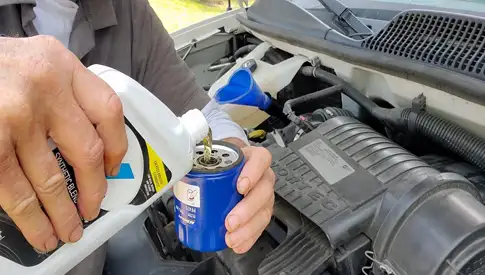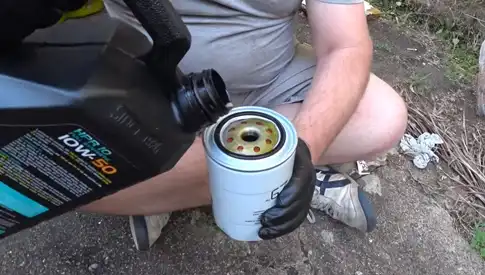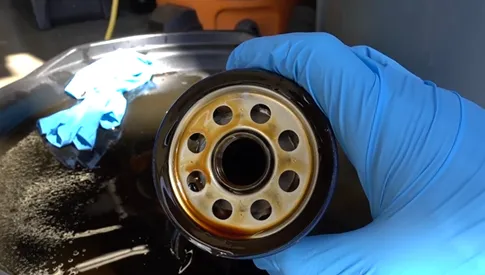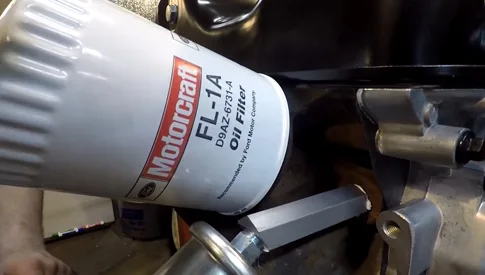Physical Address
304 North Cardinal St.
Dorchester Center, MA 02124
Physical Address
304 North Cardinal St.
Dorchester Center, MA 02124

If you’re about to install a new oil filter, it’s tempting to skip filling it with oil. Some people believe that when installing a new engine oil filter, there is no need to fill it with fresh engine oil. As the new engine oil filter will perform the same function as the old one.
But there are some fundamental reasons why filling the new oil filter with fresh engine oil before installing it. Most obviously, it lets the filter work immediately without waiting for engine oil to seep through the dry media, reducing wear on engine parts and prolonging engine life.
Filling the filter before installation will also prevent dry spots in the media, which could cause clogging and poor performance. To keep your engine running smoothly, continue reading why you should add oil to your new oil filter before mounting it & the steps for doing so.
There are several compelling reasons to ensure the oil filter is full before putting it in. Here are some of them:
The new oil filter should be filled with clean oil before installing it. This will prevent a dry start when the engine runs without lubrication for a short period until the oil pump can generate sufficient pressure to circulate the oil.
While a dry start isn’t likely to cause any serious issues, it can shorten the life of your engine by accelerating wear on moving parts. Oiling the brand-new engine oil filter before you install it will help ensure that your engine always has lubrication from the moment it starts.
Without oil in the filter, there would be a risk of air pockets forming and causing the engine to run dry. It would also be impossible for the filter to capture any contaminants present in the oil.
Adding oil to the new oil filter before installation will ensure that there will be sufficient oil flowing through the filter from the beginning. This helps to protect your engine and keep it running smoothly.
Filling the oil filter with oil before installing it helps ensure that your engine receives adequate lubrication. As engine oil circulates through the engine, it picks up dirt and other contaminants.
Contaminated oil in the engine can result in premature wear on essential components. Eventually, this can lead to serious problems, such as engine failure. By trapping these contaminants, the oil filter prevents damage to the engine. If the filter is properly filled with oil, it can do its job properly.
Consequently, the oil filter must be filled with engine oil before installation to perform its function properly. By doing so, you will be protecting your engine from damage and extending its lifespan.
If you do not fill the brand-new oil filter before installation, it will take time for the oil to reach the filter. During this time, the engine will run without lubrication which can cause immense harm. This can cause engine failure or component degradation resulting in costly repairs or replacements.
Adding oil to the filter beforehand ensures that the engine has lubrication. It is also recommended to use only clean and fresh oil when filling up the filter so that no impurities make their way into the engine along with lubrication.
In short, filling your new engine oil filter with clean engine oil before installation can save your engine from requiring expensive repairs. Moreover, it is a smart decision for car owners and DIYers alike since it can improve the performance and longevity of the engine.

Now that we’ve looked at some of the reasons you should fill the replacement oil filter with fresh oil before installing it, let’s look at how to do it:
When you change your vehicle’s engine oil, it’s a good idea to change the engine oil filter. A wrench can loosen the filter housing nuts (counterclockwise). Then unscrew the filter housing and remove the old filter. Be careful not to spill any oil, and dispose of the old filter according to your local regulations.
If the nuts are difficult to loosen, you may need to use an oil filter wrench. This specialized tool fits around the filter housing and grips it securely so you can tighten or loosen it by hand.
Before installing a new oil filter, you should clean the surface where the filter will sit. This will ensure that there is a good seal and that the filter won’t come loose. There are a few different ways to clean the mounting surface. One is to use a clean, clean cloth & another is to use brake cleaner or a similar product.
When cleaning the mounting surface, use a clean cloth to wipe away any dirt and grime since some residual oil may be left on the surface. Make sure to wipe in one direction only, and avoid using harsh chemicals or detergents that may damage your vehicle’s parts.
Now that the mounting surface is clean, you can fill the new oil filter with oil. Generally, you should use high-quality engine oil, like synthetic or semi-synthetic oil. To fill the new filter, simply pour in enough oil to coat the interior wall of the filter and allow any excess to drain down into your vehicle’s engine.
You can also use a hand pump or a syringe. If you’re using a hand pump, insert the pump’s nozzle into the opening on the side of the filter and pump until the filter is full. If you’re using a syringe, insert the needle through the filter’s opening and slowly inject engine oil until the filter is full.
After the new oil filter is filled with oil, you can install it onto the mounting surface. Again, use a wrench to loosen the nuts that secure the filter housing (counterclockwise), and then screw the housing into place by hand until it is securely fastened.
Be careful not to over-tighten the wrench, as this could harm the filter housing. Your car will run more smoothly and efficiently if you replace the engine oil filter with a little time and effort.
Now that you know how to fill the engine oil filter with fresh oil prior to installing it, you can be sure that your engine will receive the adequate lubrication it needs. This can help prolong the life of your engine and avoid costly repairs.

Before you install a new oil filter, you must put some fresh engine oil in the filter. This may seem counterintuitive, but adding oil to the filter helps to ensure adequate lubrication for the engine. Without oil, the engine will run dry and seize up, potentially causing irreparable damage.
The oil also helps to cool the engine and reduce wear on moving parts at the first start after an engine oil change. So, putting oil in the new oil filter is essential for maintaining your car’s engine. While it may take an extra step, avoiding costly repairs down the road is well worth it.

After filling up your oil filter with oil, you need to tighten it as tight as possible. If the filter is not tightened properly, the oil will escape and cause engine problems. While it may be tempting to use a power tool to tighten the filter, this can strip the threads and make the problem worse.
The best way to ensure the filter is adequately tightened is to use a torque wrench. This will allow you to apply the correct force to the filter without damaging it. But if you don’t have a torque wrench, you can still tighten the filter by hand. Just be sure to turn it slowly and evenly until it is snug.

An oil filter is a canister with a fine mesh or paper element that catches contaminants as they circulate through your engine. The oil pump pulls oil from the oil pan and pushes it through the filter where the contaminants are trapped. The clean oil then flows back to lubricate and cool various engine parts.
As oil circulates and does its job, it becomes contaminated with metal particles, dirt, and other debris. If these contaminants are not removed, they will circulate back through the engine and cause wear on various parts. Over time, this can lead to engine failure.
You already know that oil filter installation requires oil to be filled before it can be installed, so you can rely on following this step every time. When you change your engine oil, follow those steps closely each time. Maintaining your vehicle’s engine safety means remembering these tips.
Hence you can prevent costly repairs and maintain an adequate level of lubrication for your engine. Please make sure that you always consult your owner’s manual for specific instructions on how to change your oil and filter.